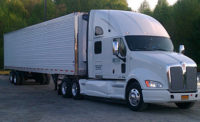How “Uberization” can apply to refrigerated transport

Living in the suburbs of Chicago, there aren’t exactly an abundance of taxis available unless arrangements are made well in advance. The process is especially difficult when trying to get a cab back to the suburbs from one of the airports. But, now, with the explosion of ride sharing companies like Uber, all of that has changed. Finding transportation that provides a taxi-like experience is now amazingly easier, more efficient, and above all, less expensive. The ride sharing companies have solved a transportation capacity issue and revolutionized the taxi industry. So, it only begs the question, can the same technology also be applied to the trucking industry?
There are many similarities between the taxi and trucking industry – they are both heavily regulated, have capacity issues, rely on a similar workforce and provide a transportation service. Enter the “Uberization” of trucking—what is considered to be the next logical step in refrigerated transportation.
The biggest issue preventing a widespread adoption of this transportation model is the number of industry regulations. Under the new rules of the upcoming Food Safety Modernization Act (FSMA), shippers of refrigerated product face significant increases in liability concerns. It will be imperative for shippers to maintain stringent shipping and transportation equipment requirements as well as documented processes. How will an “Uber” model ensure that your carrier can meet these requirements?
The federal government also seems to be in a constant state of reviewing and changing truck safety requirements. Hours-of-service, safety scores and insurance requirements have all changed and will likely change again in the near future. It is a never-ending process and difficult for a lot of shippers to manage. It has also exposed shippers to vicarious liability, meaning they can be held accountable for the actions of their hired carrier because of a failure to exercise proper due diligence. Under an “Uber” model, shippers will not have the opportunity to appropriately vet the carrier, and consequently, will leave themselves unprotected.
Another obstacle to the “Uber” model, especially in the refrigerated sector, is ensuring that product is being handled by financially-stable carriers that have the means and desire to cover freight claims. The fact is, most insurance policies will only cover certain types of damages caused by specific reasons. For example, temperature abuse is only covered by insurance if the refrigerated equipment fails; it will not cover the loss if the driver shuts off the unit to conserve fuel. The carrier will still be liable for the claim, but costs would have to be covered out of pocket. Those that would be likely to utilize the “Uber” platform are carriers with smaller businesses that have a handful of trucks and lack the funds to cover a significant loss. Once they start absorbing these losses themselves though, shippers will probably turn away from the platform.
Despite all of this, the “Uber” model already exists and is actually thriving in the trucking industry. Advances in technology have allowed freight brokers and 3PL providers to offer a lot of the same services, but without all of the risks to the shipper. The key to making it work is for the shipper to treat these entities as partners and create adequate transportation contracts. Today’s brokers and 3PLs are increasingly willing to take on these risks in order to secure the business. A fair contract allows the shipper to take advantage of improved technology, while reducing their liability exposure in the following ways:
- The shipper can specifically outline their shipping and transportation equipment requirements and put the burden of that due diligence on the broker/3PL
- A standard transportation agreement will indemnify the shipper if the broker/3PL does not perform their due diligence in hiring safe carriers
- A contract can allow the shipper to recoup losses directly from the broker/3PL in the event of unrecoverable freight claims
While I do not envision a single company revolutionizing the trucking industry as Uber did, with ride sharing, there are three significant benefits that are likely to occur in the near future because of Uber’s influence:
First, it should eventually offer shippers a more cost-effective way to do same day, short-haul moves, especially for dry LTL.
Second, it will provide better visibility across the supply chain than we have today, from shipper to carrier to receiver, and any involved intermediaries (remember the lack of visibility for tracking your taxi arrival prior to the advent of Uber?).
Finally, I agree with those that say that the “Uber” model has the potential to standardize communication in our industry. Taxis have struggled to compete with Uber from a technology standpoint, because each company is on their own platform. Even if taxis create their own phone app, every city you travel to requires users to have that specific app. The trucking industry is the same way – each carrier has their own specifications in order to get connected through electronic data interchange (EDI) or other systems.
Someone will inevitably figure out how to standardize the connections between shipper and carrier (and other supply chain partners), so it is cost effective and easy to implement. Shortly after that happens, we will look back and wonder how we ever functioned in the past.
Looking for a reprint of this article?
From high-res PDFs to custom plaques, order your copy today!





